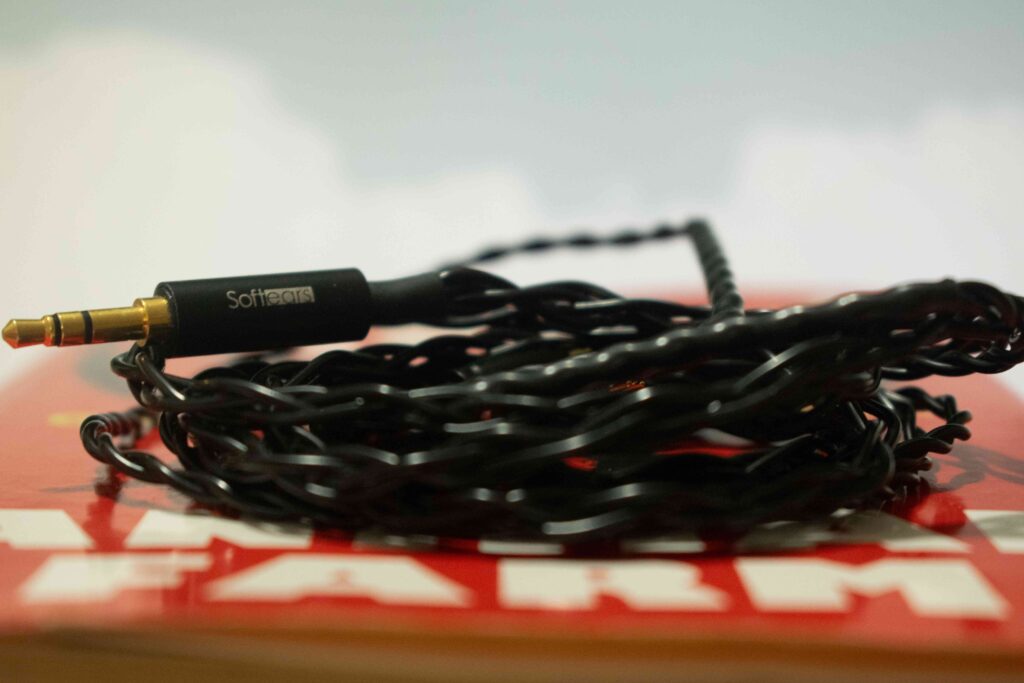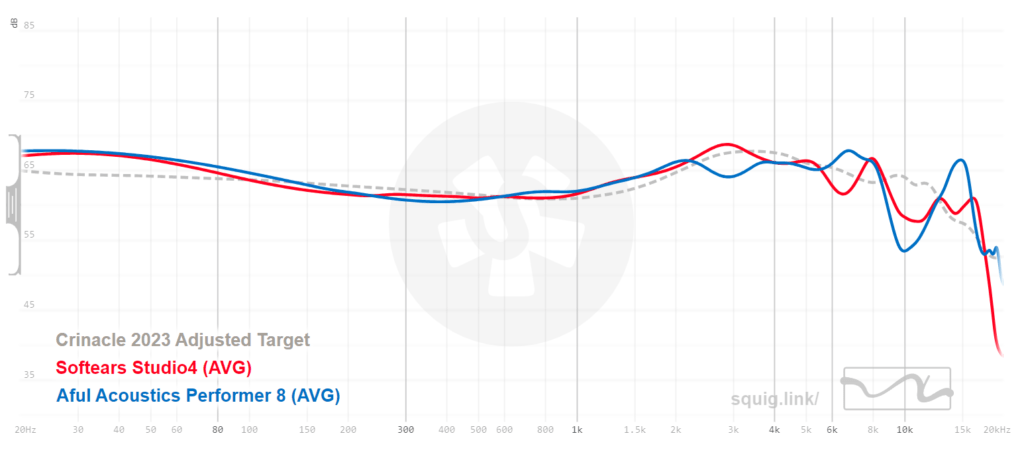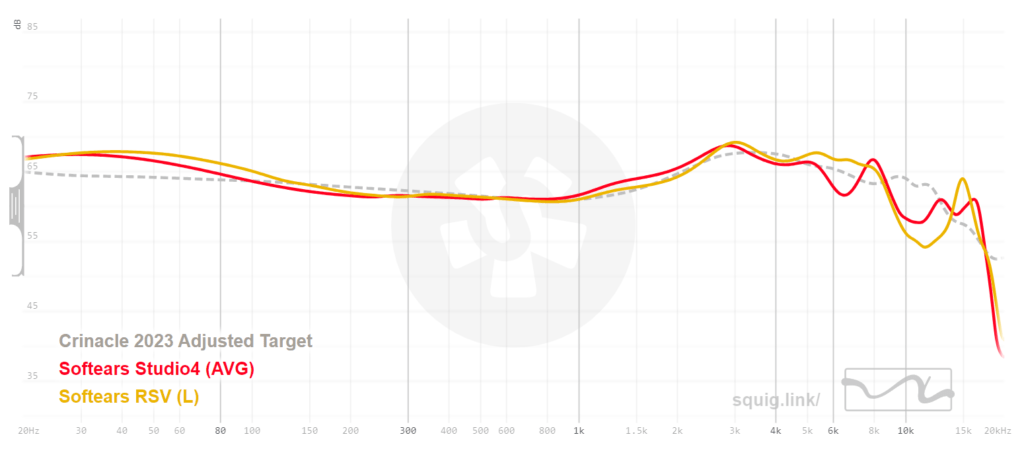Technical Specifications:-
>Impedance: 12Ω.
>Sensitivity: 123dB/Vrms.
>Shell: Medical-Grade 3D-Printed Ear Shells.
>THD+N: <1%.
>Frequency Response Range: 5Hz-40kHz.
>Effective Frequency Range: 20Hz-20kHz.
>Interface: 0.78mm 2-pin Connectors.
>Termination Plug: 3.5mm Single-Ended.
Build quality/durability and design
I’ve been using the Softears Studio 4 for a while now, and I’ve got to say, they’ve really impressed me. Right off the bat, the build quality struck me. They’re made with this 3D printing tech that’s super precise, so every little part is just perfect. The material feels premium too—it’s this medical-grade resin that’s tough but doesn’t irritate my skin, even after hours of wearing them.
Design-wise, they’re pretty sleek. All black, nothing too flashy, but they have this professional look that I dig. They’re also surprisingly light. I mean, you can tell they’re solidly built, but they don’t feel heavy in your ears at all. And they fit really well, which is a big deal for me because I hate it when IEMs keep slipping out. These stay put, and they block out noise so well, it’s like I’m in my own little bubble when I’ve got them on.
Durability is another thing I’m happy about. I’m not gentle with my gear, but these have held up great. No issues with the cable or anything.
So yeah, if you’re looking for something that’s built to last, sounds amazing, and is comfortable for those long listening sessions, the Softears Studio 4 should definitely be on your radar.
Cable
The Studio 4’s cable is made of high-purity, oxygen-free copper, which is known for its excellent signal transmission1. It’s a durable choice, with a twisted braided design that’s meant to be tangle-resistant and sturdy.
However, I understand that compared to other IEMs in the same range, you might have come across some with cables that feel more premium or offer additional features that enhance the overall user experience. It’s a valid point, and many audiophiles do prefer a cable that matches the quality and aesthetics of their IEMs.
While the cable of the Studio 4 may seem average in appearance, it’s designed to be functional and replaceable. This means you have the option to swap it out for an aftermarket cable that better suits your style and preferences, thanks to the standard 0.78mm 2-pin connectors1. It’s all about finding that perfect match for your personal listening experience
•I am using
@DUNU-Topsound Hulk Pro mini cable with this set
Tips
When you get your hands on the Softears Studio 4, you might find that the stock tips don’t quite hit the mark. They just don’t seem to do justice to the IEMs, so I tossed them aside. Instead, I’ve switched to using
Dunu Candy tips, and the difference is night and day. The fit is better, and the sound isolation improves the overall audio experience.
If you’re looking to enhance your listening sessions further, you might want to consider trying out
Spinfit W1 or
JVC Spiral Dot++ tips. These are known for their comfort and the way they can fine-tune the sound profile to your liking. It’s all about finding the right match for your ears, and with these alternatives, you’re likely to notice a significant upgrade from the default set.
•Source Dependency: The technical prowess of the Studio 4 means it performs best with high-quality recordings. Poorly recorded tracks may not benefit as much from its capabilities, and the flaws in such recordings could be made more apparent.
•Tasting source -
@Questyle M15/
@Cayin RU7/
@Shanling H5/ @Astell & kern SP1000M/
@FiiO BTR7/
@HiByMusic R3 ii/
@fosi AUDIO DS1/
@MOONDROP dawn pro/
@iFi audio hip DAC V2/ ifi zen DAC v2/ @Lg V60 (impedients unlock)/
@Sony Xperia 1 MK3
The Sound performance
The
Softears Studio 4 has garnered attention for its sound quality that’s both well-balanced and detailed. It’s praised for having an excellent tonal balance and clarity across the frequency spectrum, making it a solid choice for those who appreciate a neutral sound profile.
The bass is described as tight and controlled, which should please those who prefer precision over a bass-heavy presentation. The midrange shines with its natural and smooth character, ensuring that vocals and instruments are rendered with authenticity.
Treble in the Studio 4 is detailed and extends well, providing that sparkle and airiness without being overly sharp or sibilant. This makes it suitable for long listening sessions, as it doesn’t induce listener fatigue.
Overall, the Studio 4 seems to be a hit for those looking for an IEM that offers a professional studio sound at a competitive price point, especially within the sub-$500 category. It’s a well-regarded piece of gear among audiophiles and professionals alike.
Detailed review
Bass
The bass region is the foundation of music, providing rhythm and depth. In the
Softears Studio 4, the bass is crafted with a focus on quality over quantity.
Pros:
•Quality Over Quantity: The bass is not overemphasized, which keeps the overall sound signature neutral and balanced. This approach allows for a clear distinction between different bass layers and contributes to the overall clarity of the music.
•Sub-bass: The sub-bass has a good rumble and is well-controlled, providing enough presence to enjoy the music without overwhelming the other frequencies. It has a good weight and hits deep, enhancing tracks with a solid low-end without bleeding into the mid-bass or mids.
•Mid-bass: The mid-bass is powerful yet tight, with a deep thump that brings energy to the music. The speed is just right, ensuring that every beat is well-defined and retains its power. This results in a detailed and impactful bass response, where instruments like bass guitars sound lively and natural.
Cons:
•Subtlety May Not Suit All: Listeners who prefer a more aggressive bass might find the Studio 4’s bass too subtle. The focus on neutrality might not satisfy those looking for a bass-heavy experience.
•Detail Over Warmth: While the bass is detailed, some might miss the warmth and fullness that comes with a more pronounced bass boost, especially in genres like hip-hop or electronic dance music.
Musical and Instrumental References:
•Electronic Music: In Daft Punk’s “Around the World,” the Studio 4 delivers the driving bassline with precision, allowing the synthetic textures to come through without muddying the mid-range.
•Rock Music: The opening bass riff in Muse’s “Hysteria” is tight and punchy, showcasing the Studio 4’s ability to handle fast-paced and complex basslines.
•Classical Music: The double basses in Tchaikovsky’s “Swan Lake” have a depth and resonance that add to the orchestral tapestry without overpowering the delicate balance of the ensemble.
In conclusion, the bass of the Softears Studio 4 is designed for those who appreciate a balanced and accurate bass response. It provides a solid foundation for a wide range of music genres without ever taking center stage unnecessarily. While it may not cater to every preference, particularly for those who favor a more bass-forward sound, it stands as a testament to the pursuit of high-fidelity audio reproduction that respects the integrity of the original recording.
Mid Range
The mid-range is often considered the heart of the music, carrying the bulk of vocals and many instruments. In the Softears Studio 4, the mid-range is treated with respect and attention to detail.
Pros:
•Natural Vocal Reproduction: The mid-range is where the Studio 4 truly excels. Male vocals have a richness and depth that make them feel close and personal, as if the artist is performing right in front of you. Female vocals are crystal clear with a lively energy that can make the hairs on the back of your neck stand up.
•Instrumental Clarity: Instruments in the mid-range, like acoustic guitars and pianos, are rendered with a clean and clear presentation. The separation between instruments is impressive, allowing each one to stand out without muddying the others.
•Warmth and Body: The lower mid-range has a slight warmth that adds body to the sound, giving a fuller experience, especially noticeable in genres like jazz or blues.
Cons:
•Potential Overemphasis: Some listeners might find the mid-range a bit too forward, which could lead to a sense of congestion in very busy tracks. This might overshadow the subtleties in the music, especially in complex orchestral pieces.
Musical and Instrumental References:
•Jazz: The upright bass and saxophone in Miles Davis’ “Blue in Green” have a lushness that fills the room, thanks to the Studio 4’s mid-range capabilities.
•Rock: The rhythm guitars in The Eagles’ “Hotel California” have a presence and definition that let you hear every strum and pick on the strings.
•Classical: The cellos and violas in Yo-Yo Ma’s rendition of Bach’s Cello Suites are warm and resonant, with each note distinct and full of emotion.
Overall the mid-range of the Softears Studio 4 is a well-crafted balance of clarity and warmth. It brings vocals and instruments to life with a naturalness that’s both engaging and immersive. While it may not be perfect for every genre or every listener, it provides a sound that is both professional and accessible, making it a worthy consideration for those seeking a high-fidelity audio experience.
Treble
When we examine the treble of the Softears Studio 4, we’re entering the realm of high-frequency sounds where the magic of clarity and detail comes to life.
Pros:
•Clarity and Precision: The treble is crystal clear, allowing every high note to be heard with precision. It’s like the clear ring of a bell in a quiet room—distinct and pure.
•Instrumental Fidelity: High-frequency instruments are reproduced with remarkable fidelity. The tinkle of a high-pitched triangle or the bright chime of a celesta is heard with a lifelike presence.
•Vocal Smoothness: Sibilant sounds in vocals, which can often be piercing, are smoothed out beautifully. Listening to the soaring vocals of Freddie Mercury in Queen’s “Somebody to Love” is a treat, with every ‘s’ and ‘t’ sounding smooth and controlled.
Extended Listening: The treble is tuned to avoid listener fatigue. You can enjoy your favorite albums back-to-back, like Pink Floyd’s “The Dark Side of the Moon,” without any discomfort.
Cons:
•Reserved Sparkle: Some audiophiles might find the treble slightly reserved. While it’s detailed, it doesn’t have the sparkle that some may expect when listening to the cymbals in a live jazz recording.
•Instrumental Energy: While the treble is clear, it may lack a bit of energy. The crisp attack of a snare drum or the bright brass in a symphony orchestra might not have the bite that some listeners prefer.
•Soundstage Perception: The precise treble contributes to a wide soundstage, which is excellent for orchestral pieces like Beethoven’s “Symphony No.9.” However, this can sometimes make intimate acoustic sessions feel less cozy.
(Not exactly cons)
Musical and Instrumental References:
•Classical Music: In a piece like Vivaldi’s “Four Seasons,” the Studio 4 allows the violins to sing with a natural brightness, capturing the nuances of the bowing technique.
•Rock Music: The electric guitar solos in AC/DC’s “Back in Black” are delivered with enough detail to appreciate the grit and distortion, yet without any harshness.
•Acoustic Performances: The fingerstyle guitar work in “Dust in the Wind” by Kansas benefits from the treble’s clarity, allowing each plucked string to resonate clearly.
In summary, the treble of the
Softears Studio 4 is designed for those who value clarity and detail over brightness and energy. It offers a refined listening experience that’s easy on the ears, making it suitable for extended use. While it may not satisfy those seeking a more vibrant treble response, it stands as a solid choice for listeners who prefer a more laid-back treble presentation.
Technical Performance
•Imaging and Layering: The Studio 4 excels in imaging, placing each instrument in its own distinct space. This creates a three-dimensional soundstage that makes listening to complex arrangements, like a live orchestra, a truly immersive experience.
•Detail Retrieval: With an impressive ability to unearth the finer details in music, the Studio 4 captures the subtle breaths a singer takes, the light touch of fingers on a piano, or the gentle brush on a drum skin.
•Note Separation: The separation of notes is precise, allowing listeners to appreciate the individuality of each note in a chord. This is particularly evident in acoustic genres, where the strumming of a guitar or the pluck of a violin string can be heard distinctly.
•Resolution: The resolution is high, meaning that the music is presented with clarity and definition. This is beneficial when listening to high-resolution audio files, where every nuance is intended to be heard.
Musical and Instrumental References:
•Classical: In Beethoven’s “Moonlight Sonata,” the Studio 4 allows each piano note to be heard with clarity and precision, from the softest pianissimo to the most robust fortissimo.
•Jazz: The intricate play between the double bass and the saxophone in John Coltrane’s “Giant Steps” is rendered with meticulous detail, allowing the listener to follow each instrument as if they were in the room.
•Rock: The layered guitar work in Pink Floyd’s “Comfortably Numb” is showcased beautifully, with each layer of sound given its own space, making the solo truly stand out.
• The Softears Studio 4 is a technical marvel that will satisfy those who seek to dissect and appreciate every aspect of their music. It’s a tool for the true audiophile, designed to reveal the layers and textures of sound that are often hidden. While it may not be the perfect fit for everyone, especially those who enjoy a ‘warmer’ or ‘bassier’ sound, its technical capabilities are undeniably impressive.
Overall Sound: The Softears Studio 4 earphones give you a sound that’s rich and full. They make music feel alive and detailed, from the deepest bass to the highest notes. Everything sounds clear and separate, so you can hear each instrument on its own and enjoy the music the way it was meant to be heard.
Recommendation: If you love music and want to hear it with all the depth and detail that your favorite artists put into it, the Studio 4 is a great choice. They’re comfortable to wear, built to last, and they make all kinds of music sound amazing. Whether you’re into classical, rock, jazz, or pop, these earphones will make your listening experience better.















































All the best.